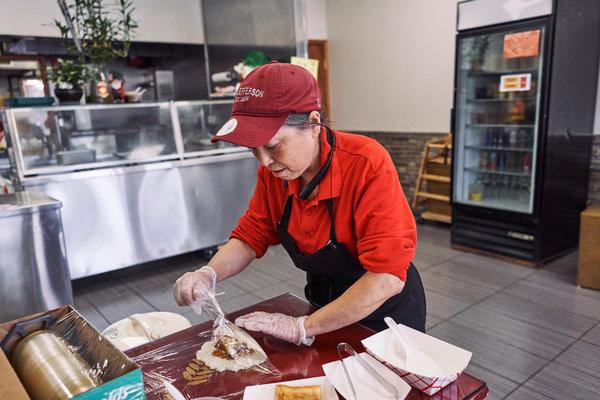In its simplest form, fan tuan is a slab of sticky rice, warm in the hand, longer than it is wide. It may be the size of a tailpipe, with a swirl of visible fillings ready to spill, or slender and sealed like a tomb, so no sign of what is buried within peeks out from either side.
At A-Pou’s Taste in East Williamsburg, Brooklyn, only one type of fan tuan is on offer, for $1.50. The owner, Doris Yao, who started selling potstickers from a street cart in 2010 and opened this modest restaurant a year and a half ago, may hand it to you herself.

Doris Yao started selling potstickers from a food cart in 2010 and opened A-Pou’s Taste a year and a half ago.CreditAn Rong Xu for The New York Times
It’s a hefty oblong, wrapped in a skin of plastic, with heat beating through it. The first bite is all rice. Only on the second do you hit treasure: you tiao, a baton of porous, unsweetened deep-fried dough; rousong, a woolly nebula of meat — here, pork — that has been simmered with star anise and ginger, shredded fine and dried nearly to desiccation; and housemade suan cai (pickled mustard greens), brightly sour.
This is breakfast, in Brooklyn as in Taipei, Taiwan’s capital, and Shanghai (where it’s called ci fan and molded into logs or rough orbs). The rice clings beautifully, and the cruller runs through it like an I-beam, keeping it stable and offering a counterpoint of crunch.
Often, the you tiao is a day old — it’s a smart way to use leftovers — and refreshed with a second round in the deep fryer. On a recent visit, it was stiff enough to require occasional gnawing. But this was a small price to pay to get to the sharp tang of suan cai and the rousong like carnal spun sugar.
Fan tuan has long been available in the Chinatowns of New York, although not always easy to find and mostly straightforward in construction. But two years ago, Nuan Xin Rice Roll opened in Sunset Park, Brooklyn, with a menu wholly devoted to variations on the breakfast snack.
The restaurant has since expanded with three more locations, two in Brooklyn and one, this month, in the Manhattan Chinatown — a block away from Jiang Xin Fan Tuan, which opened in March with the same mission and prices, $3 to $5 per roll.
In Taipei, fan tuan is a genre, treated much like Japanese onigiri or Mexican tacos, as a malleable vehicle for vegetables and protein. Modern versions there may be embedded with a whole tea egg or curls of cheese, or arrive sheathed in a scallion-flecked omelet.
At both Nuan Xin and Jiang Xin, the rice is purple, with a bruised ombre, and nuttier in taste than its white counterpart. It comes bound by nori, calling to mind a Japanese hand roll — less a matter of cross-cultural innovation than a nod to shared history: Nori entered the Taiwanese larder under the Japanese occupation in the first half of the 20th century.
Potentially more contentious is the mayonnaise squeezed into the rice. But this, too, is an ingredient true to Taiwan, where it is sweeter than in the West and slathered liberally on breakfast sandwiches. Nuan Xin uses Hellmann’s but adds secret seasonings, while Jiang Xin takes Kewpie from Japan and spikes it with fruit juice. Applied to the rice in daubs, alongside strands of iceberg lettuce, it brings an unobtrusive creaminess; more lavish and there’s a risk of glop.
Fortunately the mayonnaise is minimized or absent in the better rolls, whose contents could as easily be strewn over rice as encased in it: roast duck and braised pork gone louche in a pot with mei cai (dried pickled mustard greens) at Nuan Xin; hunks of chicken dark from long brooding in soy sauce at Jiang Xin.
The surprise is bacon, found at both spots. Suddenly the mayonnaise and iceberg make sense: This is practically a BLT, improved by its collision with salty-sweet rousong and sour pickled radish.
Still, I preferred the simpler fan tuan at A-Pou’s Taste and at Ho Foods in the East Village, where the chef, Richard Ho, started serving it for weekend brunch this past fall.
At $7, Mr. Ho’s is the most expensive — a testament to neighborhood rents, perhaps, but also to the care taken. The rice is white or purple mixed with white for extra stickiness and given a tinge of shallot oil. It isn’t ponderous, but spread as thin as a shell, just enough to contain the elemental fillings of twice-fried you tiao, rousong and pickled radish.
And that you tiao: It’s a small miracle, with a sharper crackle than any I’ve tried in Chinatown or China. Still crisp even in its cage of rice, it’s more puff than dough, a bronzing around air. Bite in, and it shatters.
Follow NYT Food on Twitter and NYT Cooking on Instagram, Facebook, YouTube and Pinterest. Get regular updates from NYT Cooking, with recipe suggestions, cooking tips and shopping advice.




